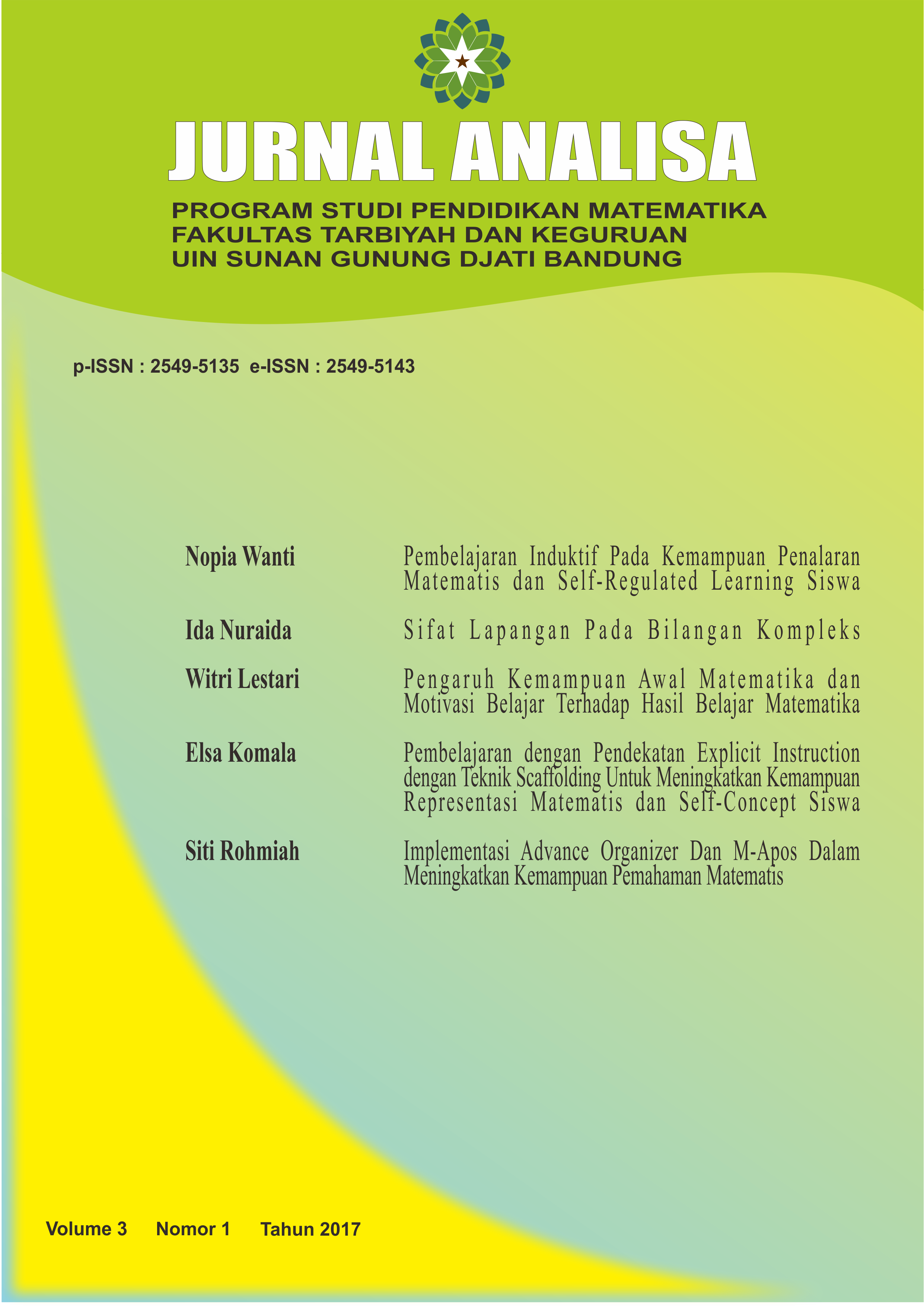Pembelajaran dengan Pendekatan Explicit Intruction dengan Teknik Scaffolding untuk Meningkatkan Kemampuan Representasi Matematis dan Self-Concept Siswa
DOI:
https://doi.org/10.15575/ja.v3i1.1500Abstract
Tujuan penelitian ini adalah untuk mendeskripsikan dan menelaah pembelajaran dengan pendekatan explicit intruction teknik scaffolding serta dampaknya terhadap kemampuan representasi matematis dan self-concept siswa. Penelitian ini merupakan penelitian kuasi eksperimen. Adapun desain penelitian yang digunakan adalah desain kelompok kontrol pretes-postes.Populasi penelitian adalah seluruh siswa kelas X di salah satu SMA Negeri di Cibadak dengan sampel dipilih dengan teknik purposive sampling. Instrumen yang digunakan berupa tes dan angket. Hasil penelitian menunjukkan bahwa peningkatan kemampuan representasi matematis siswa yang memperoleh pembelajaran dengan pendekatan pendekatan explicit intruction dengan teknik scaffolding lebih baik daripada siswa yang memperoleh pembelajaran konvensional. Hasil angket menunjukkan bahwa self-concep siswa terhadap pembelajaran matematika menggunakan pendekatan explicit intruction dengan teknik scaffolding cenderung positif artinya siswa merespon baik terhadap pembelajaran explicit intruction dengan teknik scaffolding.
References
Brooks, Jacqueline Grennon and Brooks, Martin G. 1993. The case for constructivist classrooms. Alexandria, VA: ASCD.
Cai, J, MS Jakabcsin, and Suzanne Lane. 1996. “Assessing Students’ Mathematical Communication.†School Science and … 96(5): 238–46. http://onlinelibrary.wiley.com/doi/10.1111/j.1949-8594.1996.tb10235.x/abstract.
Cronbach, L.J. 1964. Educational Psychology. New York: Harcourt, Brace & Company.
Duval, Raymond. 1999. “Representation, Vision and Visualization: Cognitive Functions in Mathematical Thinking. Basic Issues for Learning.†Twenty First Annual Meeting of the North American Chapter of the International Group for the Psychology of Mathematics Education 25(1): 3–26. http://eric.ed.gov/ERICWebPortal/recordDetail?accno=ED466379%5Cnhttp://informahealthcare.com/doi/abs/10.1076/noph.25.1.3.7140.
Goldin, G.A. 2002. Representation in Mathematics Learning and Problem Solving. Dalam L.D English (Ed). Handbook of International Research in Mathematics Education (IRME). (New Jersey: Lawrence Erlbaum Associates) hlm 209.
Jones, B.F., & Knuth, R.A. 1991. What does Research Say about Mathematics?. [on-line]. Tersedia: http://www.ncrl.org/sdrs/stwesys/2math.Html. [20 November 2012].
Kardi, Soeparman dan Muhamad Nur. 2000. Pengajaran Langsung. Surabaya: Universitas Negeri Surabaya Universiti Press.
Komala, Elsa. 2012. Pembelajaran dengan Pendekatan Diskursif untuk Meningkatkan Kemampuan Pemecahan Masalah Matematis dan Self-Concept Siswa SMP. Bandung: Tesis SPs UPI.
Leonard dan Supardi, U.S. 2010. Pengaruh Konsep Diri, Sikap Siswa pada Matematika dan Kecemasan Siswa terhadap Hasil Belajar Matematika. Cakrawala Pendidikan: FT dan FMIPA Universitas Indraprasta PGRI.
Luitel, Bal Chandra. 2002. “Representation of Mathematical Learning: A Short Discourse.†In 25th Conference Organised by Western Australian Science Education Association, Canning College.
Rosenshine, Barak, and Robert Stevens. 1984. "Classroom instruction in reading." Handbook of reading research 1. Hal: 745-798.
Sugilar, H. 2013. Meningkatkan Kemampuan Berpikir Kreatif Dan Disposisi Matematik
SiswaMadrasah Tsanawiyah Melalui Pembelajaran Generatif. [online] Jurnal Ilmiah Program Studi Matematika STKIP Siliwangi Bandung, Vol 2, No 2, September 2013.
Thomas, M. O. J & Hong, Y. 2002. Representational versatility and linear algebraic equations. In Kinshuk, R. Lewis, K. Akahori, R. Kemp, T. Okamoto, L. Henderson, & C-H. Lee (Eds.). Proceedings of the International Conference on Computers in Education, ICCE, Auckland, 2, hlm. 1002–1006.
Wahyudin. 1999. Kemampuan Guru Matematika, Calon Guru Matematika dan Siswa dalam Pembelajaran Matematika. Bandung: Tidak Diterbitkan.
Widhiarso, W. 2008. Komparasi Ketepatan Estimasi Koefisien Reliabilitas Teori Skor Murni Klasik. Yogyakarta: Tesis Fakultas Psikologi Universitas Gadjah Mada.
Wismayana, N.P. 2007. Pengaruh Model Pembelajaran Berbasis Masalah dan Adversity Questions Siswa terhadap Prestasi Belajar Matematika dan Konsep Diri Siswa SMA Negeri 4 Singaraja. JPP.
Downloads
Published
Issue
Section
License
Authors who publish in Jurnal Analisa agree to the following terms:
1. Authors retain copyright and grant the journal right of first publication with the work simultaneously licensed under a Attribution-ShareAlike 4.0 International (CC BY-SA 4.0) License that allows others to share the work with an acknowledgment of the work's authorship and initial publication in this journal.
2. Authors are able to enter into separate, additional contractual arrangements for the non-exclusive distribution of the journal's published version of the work (e.g., post it to an institutional repository or publish it in a book), with an acknowledgment of its initial publication in this journal.
3.Authors are permitted and encouraged to post their work online (e.g., in institutional repositories or on their website) prior to and during the submission process, as it can lead to productive exchanges, as well as earlier and greater citation of published work (See The Effect of Open Access).
